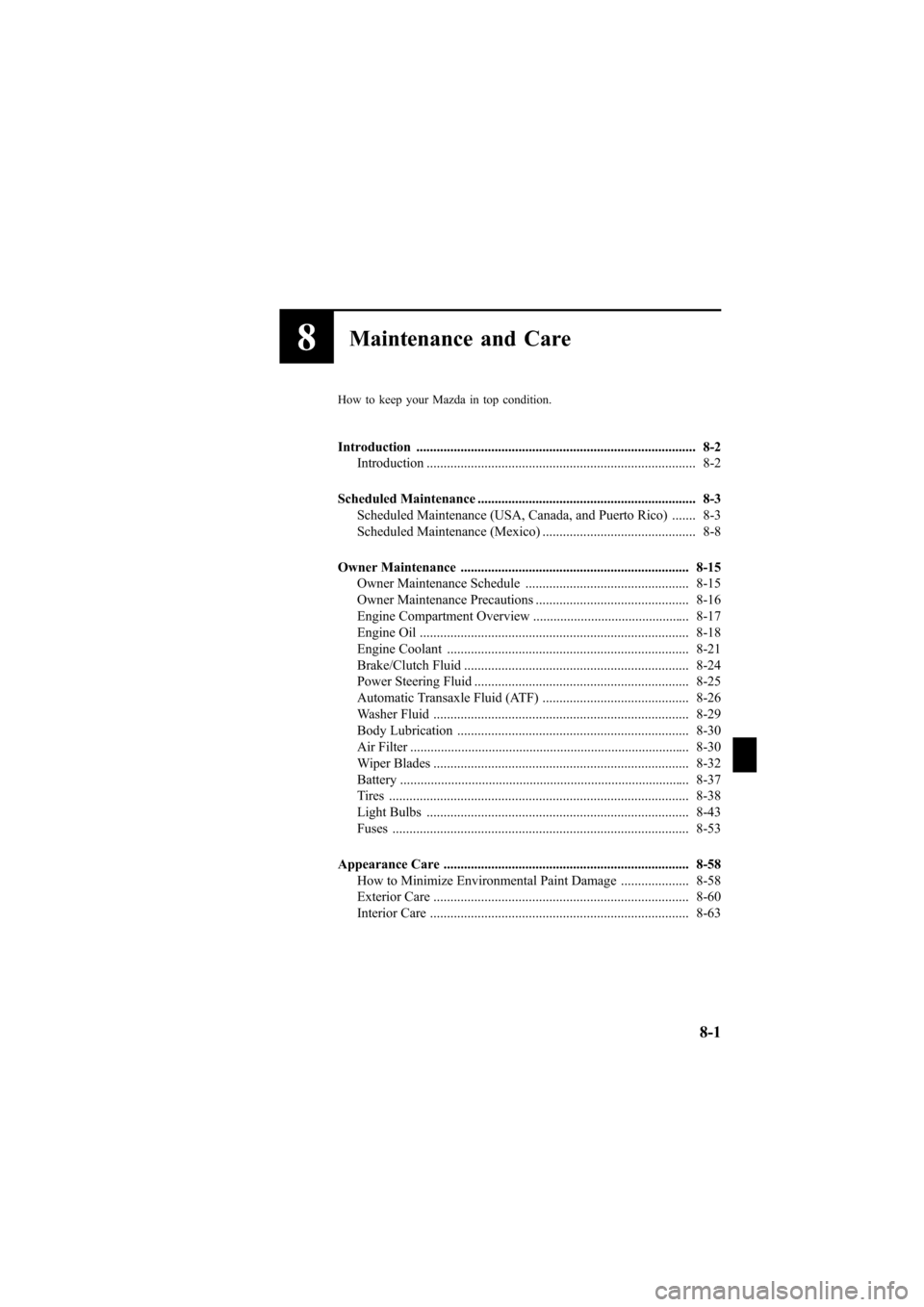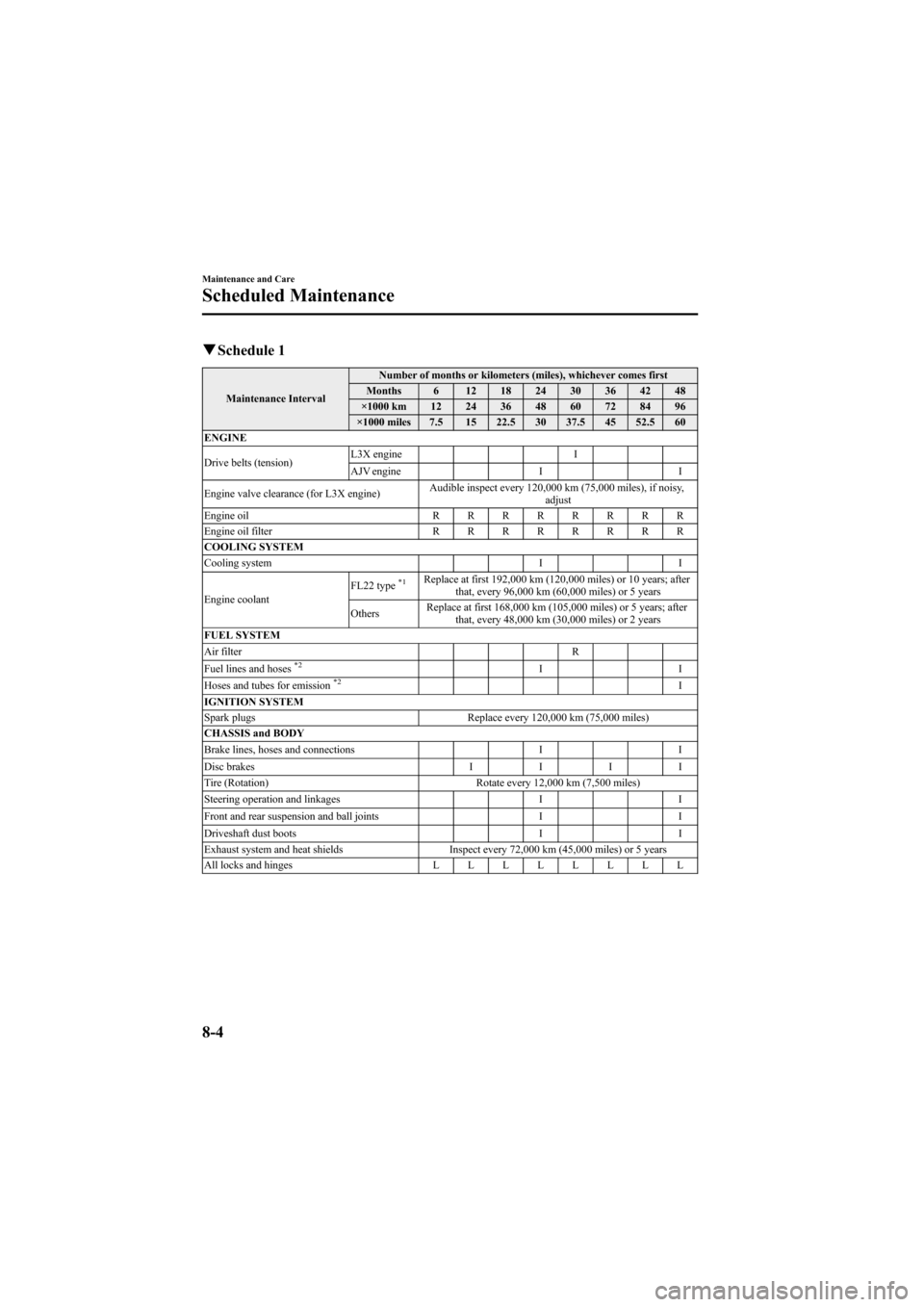MAZDA MODEL 6 2006 Owners Manual (in English)
Manufacturer: MAZDA, Model Year: 2006, Model line: MODEL 6, Model: MAZDA MODEL 6 2006Pages: 390, PDF Size: 4.29 MB
Page 261 of 390

Black plate (261,1)
Starting a Flooded Engine
If the engine fails to start, it may be
flooded (excessive fuel in the engine).
Follow this procedure:
1. Depress the accelerator all the way and
hold it there.
2. Turn the ignition switch to the START
position and hold it there―for up to 10
seconds. If the engine starts, release the
key and accelerator immediately
because the engine will suddenly rev
up.
3. If the engine fails to start, crank it
without depressing the accelerator―for
up to 10 seconds.
In Case of an Emergency
Emergency Starting
7-17
Mazda6_8U66-EA-05F_Edition1 Page261
Friday, June 3 2005 8:48 AM
Form No.8U66-EA-05F
Page 262 of 390

Black plate (262,1)
Jump-Starting
Jump-starting is dangerous if done incorrectly. So follow the procedure carefully. If you
feel unsure about jump-starting, we strongly recommend that you have a competent service
technician do the work.
WARNING
Eye Protection:
Working without eye protection is dangerous. Battery fluid contains SULFURIC
ACID which could cause blindness if splashed into your eyes. Also, hydrogen gas
produced during normal battery operation, could ignite and cause the battery to
explode. Always wear eye protection when working near the battery.
Spilled Battery Fluid:
Spilled battery fluid is dangerous.
Battery fluid contains SULFURIC ACID which could cause serious injuries if it gets
in eyes, skin or clothing. If this happens, immediately flush your eyes with water for
15 minutes or wash your skin thoroughly and get medical attention. Wear eye
protection and protective gloves to prevent contact with battery fluid.
Children and Batteries:
Allowing children to play near batteries is dangerous. Battery fluid could cause
serious injuries if it gets in the eyes or on the skin. Always keep batteries out of the
reach of children.
Keep Flames Away:
Flames and sparks near open battery cells are dangerous. Hydrogen gas, produced
during normal battery operation, could ignite and cause the battery to explode. An
exploding battery can cause serious burns and injuries. Keep all flames including
cigarettes and sparks away from open battery cells. When working near a battery, do
not allow metal tools to contact the positive (
) or negative () terminal of the
battery. Do not allow the positive () terminal to contact the vehicle body.
Battery-Related Explosion:
Flames and sparks near open battery cells are dangerous. Hydrogen gas, produced
during normal battery operation, could ignite and cause the battery to explode. An
exploding battery can cause serious burns and injuries. Keep all flames, including
cigarettes, and sparks away from open battery cells.
7-18
In Case of an Emergency
Emergency Starting
Mazda6_8U66-EA-05F_Edition1 Page262
Friday, June 3 2005 8:48 AM
Form No.8U66-EA-05F
Page 263 of 390

Black plate (263,1)
WARNING
Low Fluid Level or Frozen Battery:
Jump-starting a frozen battery or one with a low fluid level is dangerous. It may
rupture or explode, causing serious injury.
Don't jump-start a frozen battery or one with a low fluid level.
Connecting to Negative Terminal:
Connecting the end of the second cable to the negative () terminal of the discharged
battery is dangerous.
A spark could cause the gas around the battery to explode and injure someone.
Connect the negative cable to a good ground point away from the battery.
Connecting Jumper Cable to Moving Parts:
Connecting a jumper cable near or to moving parts (cooling fans, belts) is dangerous.
The cable could get caught when the engine starts and cause serious injury. Never
connect a jumper cable to or near any part that moves.
CAUTION
Use only a 12 V booster system. You can damage a 12 V starter, ignition system, and
other electrical parts beyond repair with a 24 V power supply (two 12 V batteries in
series or a 24 V motor generator set).
1. Make sure the booster battery is 12 V
and that its negative terminal is
grounded.
2. If the booster battery is in another
vehicle, don't allow the vehicles to
touch. Turn off the engine of the
vehicle with the booster battery and all
unnecessary electrical loads in both
vehicles.
3. Connect the jumper cables in the exact
sequence as in the illustration.
lConnect one end of a cable to the
positive terminal on the discharged
battery (1).
lAttach the other end to the positive
terminal on the booster battery (2).
lConnect one end of the other cable
to the negative terminal of the
booster battery (3).
In Case of an Emergency
Emergency Starting
7-19
Mazda6_8U66-EA-05F_Edition1 Page263
Friday, June 3 2005 8:48 AM
Form No.8U66-EA-05F
Page 264 of 390

Black plate (264,1)
lConnect the other end to a solid,
stationary, exposed metallic point
(for example, the strut mounting
bolt) away from the discharged
battery (4).
Connect cables in
numerical order and
disconnect in reverse
order.
Discharged
batteryJumper cables
Booster battery
4. Start the engine of the booster vehicle
and run it a few minutes. Then start the
engine of the other vehicle.
5. When finished, carefully disconnect the
cables in the reverse order described in
Step 3.
Push-Starting
WARNING
Towing a Vehicle to Start It:
Towing a vehicle to start it is
dangerous. The vehicle being towed
could surge forward when its engine
starts, causing the two vehicles to
collide. The occupants could be
injured. Never tow a vehicle to start it.
You can't start a vehicle with an automatic
transaxle by pushing it.
CAUTION
Do not push-start a vehicle that has a
manual transaxle. It can damage the
emission control system.
7-20
In Case of an Emergency
Emergency Starting
Mazda6_8U66-EA-05F_Edition1 Page264
Friday, June 3 2005 8:48 AM
Form No.8U66-EA-05F
Page 265 of 390

Black plate (265,1)
Towing Description
We recommend that towing be done only
by an Authorized Mazda Dealer or a
commercial tow-truck service.
Proper lifting and towing are necessary to
prevent damage to the vehicle.
Government and local laws must be
followed.
A towed vehicle usually should have its
front wheels off the ground. If excessive
damage or other conditions prevent this,
use wheel dollies.
Wheel dollies
When towing with the rear wheels on the
ground, release the parking brake.
CAUTION
Don't tow the vehicle pointed backward
with driving wheels on the ground. This
may cause internal damage to the
transaxle.
CAUTION
Don't tow with sling-type equipment.
This could damage your vehicle. Use
wheel-lift or flatbed equipment.
In Case of an Emergency
Emergency Towing
7-21
Mazda6_8U66-EA-05F_Edition1 Page265
Friday, June 3 2005 8:48 AM
Form No.8U66-EA-05F
Page 266 of 390

Black plate (266,1)
CAUTION
Do not use the hooks under the rear
bumper for towing and tying down, as
they cannot hold the load and it will
damage the bumper.
Hooks
Recreational Towing
An example of“recreational towing”is
towing your vehicle behind a motorhome.
The transaxle is not designed for towing
this vehicle on all 4 wheels.
When doing recreational towing refer to
“Towing Description”(page 7-21) and
carefully follow the instructions.
7-22
In Case of an Emergency
Emergency Towing
Mazda6_8U66-EA-05F_Edition1 Page266
Friday, June 3 2005 8:48 AM
Form No.8U66-EA-05F
Page 267 of 390

Black plate (267,1)
8Maintenance and Care
How to keep your Mazda in top condition.
Introduction .................................................................................. 8-2
Introduction ............................................................................... 8-2
Scheduled Maintenance ................................................................ 8-3
Scheduled Maintenance (USA, Canada, and Puerto Rico) ....... 8-3
Scheduled Maintenance (Mexico) ............................................. 8-8
Owner Maintenance ................................................................... 8-15
Owner Maintenance Schedule ................................................ 8-15
Owner Maintenance Precautions ............................................. 8-16
Engine Compartment Overview .............................................. 8-17
Engine Oil ............................................................................... 8-18
Engine Coolant ....................................................................... 8-21
Brake/Clutch Fluid .................................................................. 8-24
Power Steering Fluid ............................................................... 8-25
Automatic Transaxle Fluid (ATF) ........................................... 8-26
Washer Fluid ........................................................................... 8-29
Body Lubrication .................................................................... 8-30
Air Filter .................................................................................. 8-30
Wiper Blades ........................................................................... 8-32
Battery ..................................................................................... 8-37
Tires ........................................................................................ 8-38
Light Bulbs ............................................................................. 8-43
Fuses ....................................................................................... 8-53
Appearance Care ........................................................................ 8-58
How to Minimize Environmental Paint Damage .................... 8-58
Exterior Care ........................................................................... 8-60
Interior Care ............................................................................ 8-63
8-1
Mazda6_8U66-EA-05F_Edition1 Page267
Friday, June 3 2005 8:48 AM
Form No.8U66-EA-05F
Page 268 of 390

Black plate (268,1)
Introduction
Be extremely careful and prevent injury to yourself and others or damage to your vehicle
when using this manual for inspection and maintenance.
If you're unsure about any procedure it describes, we strongly urge you to have a reliable
and qualified service shop perform the work, preferably an Authorized Mazda Dealer.
Factory-trained Mazda technicians and genuine Mazda parts are best for your vehicle.
Without this expertise and the parts that have been designed and made especially for your
Mazda, inadequate, incomplete, and insufficient servicing may result in problems. This
could lead to vehicle damage or an accident and injuries.
For expert advice and quality service, consult an Authorized Mazda Dealer.
The owner should retain evidence that proper maintenance has been performed as
prescribed.
Claims against the warranty resulting from lack of maintenance, as opposed to defective
materials or authorized Mazda workmanship, will not be honored.
Any auto repair shop using parts equivalent to your Mazda's original equipment may
perform maintenance.But we recommend that it always be done by an Authorized
Mazda Dealer using genuine Mazda parts.
8-2
Maintenance and Care
Introduction
Mazda6_8U66-EA-05F_Edition1 Page268
Friday, June 3 2005 8:48 AM
Form No.8U66-EA-05F
Page 269 of 390

Black plate (269,1)
Scheduled Maintenance (USA, Canada, and Puerto Rico)
Follow Schedule 1 if the vehicle is operated mainly where none of the following conditions
apply.
If any do apply, follow Schedule 2 (Canada and Puerto Rico residents follow Schedule 2).
lRepeated short-distance driving
lDriving in dusty conditions
lDriving with extended use of brakes
lDriving in areas where salt or other corrosive materials are being used
lDriving on rough or muddy roads
lExtended periods of idling or low-speed operation
lDriving for long periods in cold temperatures or extremely humid climates
NOTE
After the prescribed period, continue to follow the described maintenance at the
recommended intervals.
Maintenance and Care
Scheduled Maintenance
8-3
Mazda6_8U66-EA-05F_Edition1 Page269
Friday, June 3 2005 8:48 AM
Form No.8U66-EA-05F
Page 270 of 390

Black plate (270,1)
qSchedule 1
Maintenance IntervalNumber of months or kilometers (miles), whichever comes first
Months 6 12 18 24 30 36 42 48
×1000 km 12 24 36 48 60 72 84 96
×1000 miles 7.5 15 22.5 30 37.5 45 52.5 60
ENGINE
Drive belts (tension)L3X engine I
AJV engine I I
Engine valve clearance (for L3X engine)Audible inspect every 120,000 km (75,000 miles), if noisy,
adjust
Engine oilRRRRRRRR
Engine oil filterRRRRRRRR
COOLING SYSTEM
Cooling system I I
Engine coolantFL22 type
*1Replace at first 192,000 km (120,000 miles) or 10 years; after
that, every 96,000 km (60,000 miles) or 5 years
OthersReplace at first 168,000 km (105,000 miles) or 5 years; after
that, every 48,000 km (30,000 miles) or 2 years
FUEL SYSTEM
Air filter R
Fuel lines and hoses
*2II
Hoses and tubes for emission*2I
IGNITION SYSTEM
Spark plugs Replace every 120,000 km (75,000 miles)
CHASSIS and BODY
Brake lines, hoses and connections I I
Disc brakesIIII
Tire (Rotation) Rotate every 12,000 km (7,500 miles)
Steering operation and linkages I I
Front and rear suspension and ball joints I I
Driveshaft dust boots I I
Exhaust system and heat shields Inspect every 72,000 km (45,000 miles) or 5 years
All locks and hingesLLLLLLLL
8-4
Maintenance and Care
Scheduled Maintenance
Mazda6_8U66-EA-05F_Edition1 Page270
Friday, June 3 2005 8:48 AM
Form No.8U66-EA-05F